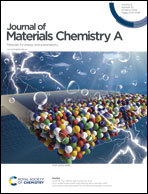Comprehensive interface engineering based on target anchoring agents for efficient and stable inverted perovskite solar cells†
Abstract
Two pervasive challenges encountered in inverted perovskite solar cells (PSCs) are difficulties in depositing high-quality and reproducible perovskite thin films and unsatisfactory device stability in ambient air. One constraint is the poor surface wettability of buried hole transport materials (HTMs) such as poly(triarylamine) (PTAA), which induces weak layer contact and impedes interfacial charge extraction. Another is that the impurity-induced surface defects of perovskite layers pose a significant threat to the stability and reproducibility of PSCs. To tackle these issues, we propose a strategy that introduces the amine molecule 4,4′,4′′-tris(3-methyl phenyl phenylamino)triphenylamine (m-MTDATA) into a PTAA/perovskite interface as a target modification to enhance the wettability of PTAA. The PTAA/m-MTDATA bilayer is found to align the energy levels of HTMs. Furthermore, phenyl ammonium bromide (PhABr) is deposited onto the perovskite surface to remove excessive residual PbI2 for the reduction of uncoordinated Pb2+ and iodide vacancies. A target device with m-MTDATA and PhABr achieves an impressive efficiency of 22.56% with negligible hysteresis, which is significantly higher than that of a pristine device (19.69%). Moreover, the device also shows significantly enhanced resistance to moisture, thermal stability and continuous light illumination. The strategy of target anchoring agents is feasible for high-performance inverted PSCs with enhanced stability.



 Please wait while we load your content...
Please wait while we load your content...